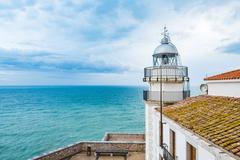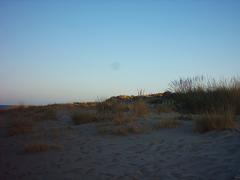Peñíscola Castle: Visiting Hours, Tickets & Historical Highlights
Date: 04/07/2025
Introduction
Peñíscola Castle, also known as Castillo de Peñíscola or the Castle of Papa Luna, is one of Spain’s most iconic and historically significant fortresses. Dramatically perched atop a rocky promontory 64 meters above the Mediterranean Sea, the castle invites visitors to journey through centuries of layered history, from its Templar origins to its transformation into a papal residence. Today, it stands as a meticulously preserved monument blending medieval grandeur with modern visitor amenities, making it a must-visit destination for history enthusiasts, architecture lovers, and travelers alike (Spain.info).
This guide provides detailed information about Peñíscola Castle visiting hours, ticket options, accessibility, and travel tips, as well as an exploration of its historical, architectural, and cultural significance. For the most current details, consult the official tourism platform and the Castillo de Peñíscola Official Site.
Table of Contents
- Historical Foundations and Strategic Importance
- Architectural Legacy and Evolution
- The Papal Era and the Western Schism
- Military Conflicts and Later Use
- Visiting Peñíscola Castle: Hours, Tickets, and Practical Information
- Exploring the Castle: Interior & Panoramic Highlights
- Visitor Amenities and Accessibility
- Guided Tours and Interpretation
- Nearby Attractions and Complementary Experiences
- FAQs
- Practical Tips for a Memorable Visit
- Visitor Feedback and Ratings
- Conclusion and Call to Action
- References
Historical Foundations and Strategic Importance
The site of Peñíscola Castle has been of strategic importance since ancient times. Archaeological finds indicate occupation as far back as the Ibero-Roman period (1st–2nd centuries BC). Later, during the Moorish era, the fortress was described by the geographer Al-Idrisi as “Baniskula,” a key stronghold overlooking the sea (Comunitat Valenciana).
Its current form arose after the Christian Reconquista. In 1229, the last Almohad governor of Valencia, Zayd Abu Zayd, surrendered Peñíscola to James I of Aragon. By 1294, James II entrusted the site to the Knights Templar, who demolished the Muslim fortifications and constructed the fortress that stands today, completed in 1307. The castle’s cliffside location and commanding views made it a vital defensive hub for maritime and land-based threats (Spain.info).
Architectural Legacy and Evolution
Peñíscola Castle is renowned for its blend of Romanesque, Gothic, and Renaissance architectural styles, reflecting the site’s continuous adaptation to evolving military and residential needs.
Key Features:
- Templar Core: Characterized by robust, barrel-vaulted stone halls, thick walls, and minimal ornamentation—hallmarks of Templar military architecture.
- Chapel: A barrel-vaulted Romanesque chapel, a spiritual center since the Templar era.
- Defensive Structures: Massive curtain walls, towers, and later Renaissance artillery bastions engineered in the 16th century to withstand cannon fire.
- The Mastia Tower: The castle’s highest point, providing panoramic views of the coastline and town.
- Pope’s Chambers: Rooms modified during the papal era, enriched with Gothic and early Renaissance details.
Even today, the castle’s integration with the natural rock base enhances its defensive prowess and architectural uniqueness (CastleTourist).
The Papal Era and the Western Schism
In the early 15th century, Peñíscola Castle became a focal point in Catholic history as the residence of Antipope Benedict XIII, or Papa Luna, during the Western Schism. From 1411 to 1423, Benedict XIII transformed the castle into a papal palace and court, adding private chambers, audience halls, and fortified chapels. His presence imbued the fortress with ecclesiastical prestige and led to further architectural refinement (Travelling Jezebel).
Military Conflicts and Later Use
Peñíscola Castle’s strategic value continued through the ages, playing key roles in the War of the Spanish Succession, the Peninsular War, and various 19th-century conflicts. Its defensive features were continually upgraded to meet advances in siege warfare, most notably under military engineer Giovanni Battista Antonelli in the 16th century, who added angular bastions and artillery platforms. The garrison was finally disbanded in 1890, but the fortress remains a symbol of resilience (DuckExplore).
Visiting Peñíscola Castle: Hours, Tickets, and Practical Information
- Opening Hours: Generally open daily. Summer (April–October): 10:00 AM–8:00 PM; Winter (November–March): 10:00 AM–6:00 PM. Holiday hours may differ—check the official website for updates.
- Tickets: Standard adult admission is approximately €5–€6. Discounts are available for seniors, students, and children under 12. Family passes and guided tour tickets are also offered. Purchase at the entrance or online (recommended in high season).
- Entry: Access is via the main gate at the top of the old town; parking is available outside the historic core (Travelling Jezebel).
Exploring the Castle: Interior & Panoramic Highlights
- Main Halls and Chapels: Explore the austere Templar halls, dungeons, and the barrel-vaulted chapel.
- Papa Luna’s Quarters: Visit the rooms and displays dedicated to Benedict XIII, including artifacts and interpretive panels on the Western Schism.
- Artillery Park (El Parc d’Artilleria): Adjacent to the castle, this former bastion is now a landscaped garden with cannons and filming locations from Game of Thrones (Things.in).
- Terraces and Ramparts: Climb to the upper terraces for sweeping views of the Mediterranean, the town, and the Sierra de Irta mountains. Sunset visits are especially rewarding.
- Museu de la Mar: At the castle’s base, this maritime museum explores Peñíscola’s seafaring history.
Visitor Amenities and Accessibility
- Facilities: Restrooms and a gift shop are located inside the castle complex. Numerous cafés and restaurants are found just outside the entrance (Govalencian).
- Accessibility: Due to medieval construction, the castle has steep stairs and uneven stone floors, limiting wheelchair and stroller access to certain areas. Key sections are accessible, and assistance is available upon request.
- Parking: Available outside the old town; early arrival is recommended during peak periods.
Guided Tours and Interpretation
Guided tours are available in several languages, offering in-depth historical context on the Templar origins, papal history, and architectural evolution. Audio guides may also be provided for self-guided visits. Some tours include Game of Thrones filming locations and highlights of the old town (Travelling Jezebel).
Nearby Attractions and Complementary Experiences
- Old Town: Wander the labyrinthine, whitewashed streets filled with boutiques, tapas bars, and artisan shops.
- Lighthouse of Peñíscola: Built in 1892, adjacent to the castle, offering classic coastal views.
- El Bufador: A natural blowhole near San Pedro Gate.
- La Casa de las Conchas: A house covered in seashells, reflecting local artistic traditions.
- Church of the Virgen de la Ermitana: Baroque architecture and cultural significance.
- Sierra de Irta Natural Park: Hiking and nature trails just beyond the town.
FAQs
What are Peñíscola Castle’s visiting hours?
Typically 10:00 AM–8:00 PM in summer, 10:00 AM–6:00 PM in winter. Check the official website for seasonal changes.
How much are tickets?
Standard adult tickets are €5–€6, with discounts for seniors, students, and children. Tickets are available online or at the entrance.
Is the castle accessible for people with disabilities?
Some areas are accessible, but much of the castle is not due to steep steps and uneven ground. Assistance is available upon request.
Are guided tours available?
Yes, in multiple languages, with audio guides and special focus tours offered.
What are the best times to visit?
Early morning, late afternoon, and shoulder seasons (June, September, October) offer pleasant weather and fewer crowds.
Practical Tips for a Memorable Visit
- Wear Comfortable Shoes: The castle’s stone floors and staircases can be uneven.
- Bring Sun Protection and Water: Especially in hot summer months.
- Photography: Early or late in the day provides the best light.
- Respect Historic Features: Climbing on walls or touching artifacts is prohibited.
- Check for Events: The castle hosts exhibitions, concerts, and cultural events throughout the year.
Visitor Feedback and Ratings
Peñíscola Castle is highly rated by visitors, with praise for its preservation, historical displays, and panoramic vistas. Over 68,000 Google reviews average 4.6 out of 5 stars, making it a top recommendation for families, photographers, and history enthusiasts alike (Things.in).
Conclusion and Call to Action
Peñíscola Castle stands as a living testament to Spain’s military, religious, and cultural heritage. Its robust Templar foundations, papal history, and Renaissance defenses invite exploration, while its breathtaking setting atop the Mediterranean promises an unforgettable experience. For up-to-date visiting hours, ticketing, and travel tips, consult official resources and consider downloading the Audiala app for guided tours and insider advice.
Plan your journey today to discover why Peñíscola Castle is celebrated as one of Spain’s most captivating fortresses.
For further details and planning resources, visit Spain.info, Castillo de Peñíscola Official Site, and Comunitat Valenciana.
References
- Peñíscola Castle: Visiting Hours, Tickets, History, and Travel Tips for This Iconic Spanish Fortress, 2025, Spain.info
- Peñíscola Castle Visiting Hours, Tickets & Architectural Highlights: Your Ultimate Guide, 2025, Audiala
- Peñíscola Castle Visiting Hours, Tickets, and Historical Guide, 2025, Travelling Jezebel
- Peñíscola Castle Visiting Hours, Tickets, and Guide to Peñíscola Historical Sites, 2025, Comunitat Valenciana
- Peñíscola Spain Travel Guide 2025, DuckExplore
- CastleTourist
- CastlePedia
- Things.in
- Govalencian

